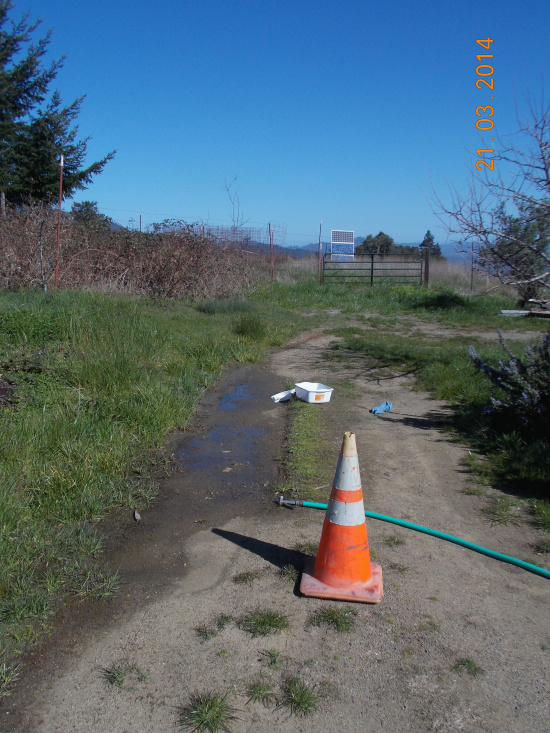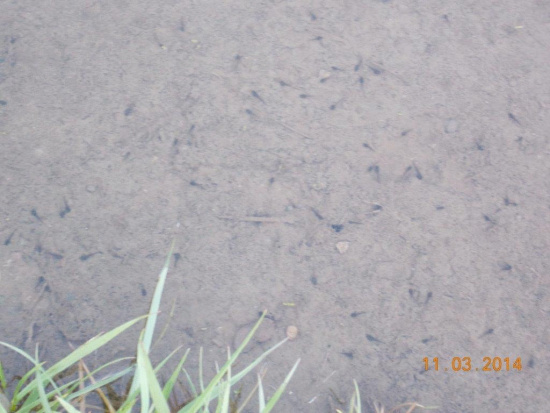A guest photo essay on hope and Nature by Charley Custer, a Southern Humboldt resident.
As Mark Twain almost said, “Everyone talks about the drought, but no one does anything about it.”
Take this, Mark Twain:
After the first real winter rains came a few weeks ago, our regular driveway seep finally started filling its dry puddle-hole below our cabin. As usual, chorus frogs found in it a romantic getaway—to get away from the bullfrogs in real ponds, that is, who think choruses are for chowing down. After the rains there were scores of little egg sacs in our seep puddle, and not a bullfrog in sight.
With our aquifers and amphibians so challenged and parched this year, my wife and I closed off the driveway to give these not-yet babies their fair shot at fulfillment.
But the seep dried up. Our normal perma-puddle in this winter of drought had become a lousy vernal spring! Luckily, the web-weather showed our latest storm system just a few days away. And our main spring wasn’t dry. I stretched our hose out to the puddle, aimed it at a tuft of grass to scatter its flow, and we watered that puddle full of frog egg sacs in our driveway for two days, until the rains returned.
It’s easy to feel hopeless and overpowered by uncertainties and climate change. I wish I could do something for endangered coho, for cutthroat salmon and green sturgeon, something less abstract than conserving water. But at home I can actually give a hand to our native frog neighbors who are harried by big fat immigrant bullfrogs sweeping across our ridge—I can even take comfort that our bully bullfrogs are themselves fodder for a family of minks feeding from our pond up by the cabin, to judge by the pond’s eerie silence this winter, and a baby mink-tail our cat dragged in. It’s as if everything works out.
The new rains are inspiring new romance in my driveway puddle, while the first tadpoles from the last orgies burrow into the silt of our protected wetland. All this makes me feel like a high-achieving prince, or at least a well-functioning government.
Our puddle’s intermittent seep puts our main spring in perspective, too. Its flows typically rise to a flood in January, after 14 inches of rainfall. This year we didn’t get that much rain until March—and nothing happened. Finally, with 20 inches of local rain for the rain-year, our spring started rising, and I laid in our winter hydropower, which we share with a couple of neighbors. But not for long. The ground was so dry our spring needed more rain than usual to rise at all, and then its pulse of power rose less than normal, and died back rapidly. But this last round of rains is jazzing up our juice once more, no doubt not for as long I’d like. I can’t take for granted the miracle of waters gushing from its long gully-gash of rock.
Yet I don’t feel powerless. Implacable forces of chance, greed and folly smack us with despair at stopping increasing drought, fire and ocean floods—and their likely driver, climate change—yet even while we worry, the world spins through its ups and downs, possibly equally implacably. Records from the last 150 years show rainfall in California getting strikingly more extreme in yearly variance, yet on average, the same sum of rain falls. The problem is how few years are still average. But as I stand over the squiggly little sperms I’ve foster-fathered on our ex-driveway, I feel happy to be Mr Averaging Guy. My homestead actions have finger-tipped Creation toward a sweet spot for teeming handfuls of tadpoles between famine and flood, a balance achieved by sharing water as well as storing it.
Doing both, and doing more, isn’t just essential, it satisfies the soul. The truth is, our little driveway mud puddle brings me joy. What we’re really watering—besides my tadpoles, who do me proud, growing up so fast!—is hope. Which springs vernal at least, maybe even eternal.
Epilogue
I wasn’t planning to water our frog sanctuary all spring, but with the drought continuing, the seep dried again and I started transporting our more than 1000 tadpoles, the wee sprats about a fifth the size of their big siblings, into our pond a couple hundred feet away. I did this over several days, using a dustpan and a dishpan. Here’s what was left of the pond this morning when I came for the last stragglers:
And this was the murderous scene I’d abandoned my foster frogs to. Can you see the footprints of feeding birds? Oddly, though sparrows and chicadees bathed in the puddle before it filled with teeming tadpoles, now their bigger kin only feed from the banks.
Was it all worthwhile? Can’t say until the fat froggies sing—but what else is there?






CLICK TO MANAGE